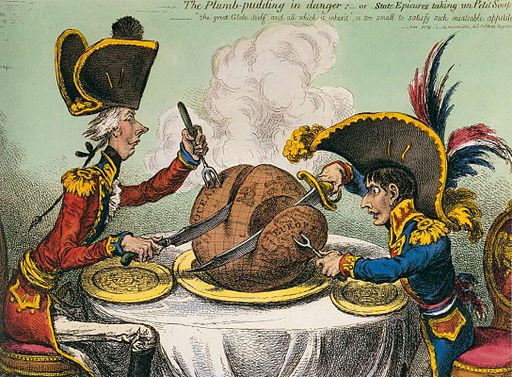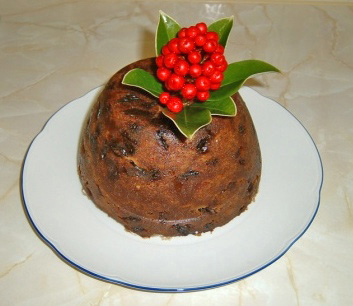
I sat enjoying the evening breeze, when the Handsome Bloke said, “I fancy Christmas Pudding this year.” Was he joking? No, he wore a meaningful look. “Oh,” said I.
“I don’t suppose our grocery store has any in for the holidays?”
“I’ll ask.”
Wait a minute! What about the picture? What is the picture about? Oh, that. James Killray produced the cartoon in 1805 when the Napoleonic Wars were raging. England in red and France in blue are carving up Europe…errr, the pudding.
Ahem! As I was starting to say, Christmas Pudding is an English dessert served after Christmas dinner. [Sidebar: The English don’t have “dessert;” they have “pudding.” Not Jello pudding or tapioca pudding. A cake could serve as a pudding. “Eat your pudding. There’s a good child.”]
The Handsome Bloke hales from Yorkshire, where the Christmas holiday meal includes roasted turkey and pudding. An elf often sends us a Marks & Spencer’s Christmas Plum Pudding, but it’s been a busy year for elves. No time to shop.
Traditional English Christmas Plum Pudding – what is that, exactly? One story says the pudding originated with a medieval custom. An anonymous pundit declared, “A pudding must be made on the 25th Sunday after Trinity Sunday; said pudding must have 13 ingredients to represent Jesus and the 12 Apostles.” That’s one way to remember how many disciples there were.
In the 14th century, Christmas pudding was porridge made of beef, mutton, raisins, currants, prunes, wines, and spices. Not too appealing. In the 17th century, enterprising cooks added eggs, breadcrumbs, dried fruit, and either beer or whiskey.
The Puritans disapproved – they banned the pudding and Christmas.
Three cheers for King George I, also known as the Pudding King. He liked Christmas, and a feast with Christmas pudding. He rather liked feasting in general, judging by some of his portraits.
While the Victorians were inventing our current holiday habits — trees, presents, and all manner of general merriment — they reinvented the Christmas pudding by putting a sprig of holly on top, dousing it with brandy and setting it alight. Ooo’s and ahh’s all around.

In his famous Christmas Carol, Charles Dickens described how Christmas pudding was served in the humble Cratchit household: “Hallo! A great deal of steam! The pudding was out of the copper which smells of washing-day. That was the cloth. A smell like at eating-house and a pastrycook’s next door to each other, with a laundress’s next door to that. That was the pudding . . . like a speckled cannon-ball, so hard and firm, blazing in half of half-a-quarter of ignited brandy and bedlight with Christmas holly stuck into the top.”
Yummy – I definitely want some of that.
I digress. The Handsome Bloke’s request was entirely reasonable. I exercised due diligence, and visited our three grocery stores (small town). None were bringing in Christmas puddings. Upon receiving my report, the Handsome Bloke went online, found a source, and ordered the pudding. Tradition meets the digital age.
No plums have been killed in the writing of this blog.
If you want to make your own Christmas Plumb Pudding, there is a charming traditional recipe at recipewise http://recipewise.co.uk/christmas-pudding-traditional-recipe If you want to order one, you might peruse selections at The British Food Shop http://www.britishfoodshop.com/christmas-pudding.asp?gclid=CK29kt6HjLQCFQ_hQgodiz0ARw
More info on Christmas puddings can be found at http://www.whychristmas.com/customs/pudding.shtml

Sandra Wagner-Wright holds the doctoral degree in history and taught women’s and global history at the University of Hawai`i. Sandra travels for her research, most recently to Salem, Massachusetts, the setting of her new Salem Stories series. She also enjoys traveling for new experiences. Recent trips include Antarctica and a river cruise on the Rhine from Amsterdam to Basel.
Sandra particularly likes writing about strong women who make a difference. She lives in Hilo, Hawai`i with her family and writes a blog relating to history, travel, and the idiosyncrasies of life.

